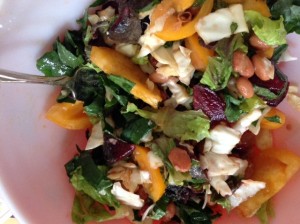I was at a Bikram Yoga class last Sunday and I saw an athlete who had attended a sports nutrition lecture I had done for their club last year. We exchanged pleasantries and he asked me “How many calories should I be taking in on the bike from carbs?” I would love to give a simple answer, but it depends on how you are eating as to how many calories you can take in.
When I work with clients, I have them complete food logs so I can get a good idea of how they eat and how well they balance the blood sugar. As you balance the blood sugar better, your body will get into a fat burning mode. This is irrespective of whether you are exercising in fat burning zones. Depending on how you eat, and how you balance the meals, your body may be burning sugar rather than fat for energy. When exercising, this is what will drive the need for sugars/carbohydrates during exercise up or down.  Increase the bagels, pasta and breads, you will be burning more sugar and needing more calories per hour while exercising. Balance the meals with limited carbohydrates, healthy fats, healthy proteins and green vegetables, and your body will more likely burn fats rather than sugar. Then during exercise, your needs for carbohydrates drops as your body burns your own fat stores for energy whether in or out of the fat burning zone.
Increase the bagels, pasta and breads, you will be burning more sugar and needing more calories per hour while exercising. Balance the meals with limited carbohydrates, healthy fats, healthy proteins and green vegetables, and your body will more likely burn fats rather than sugar. Then during exercise, your needs for carbohydrates drops as your body burns your own fat stores for energy whether in or out of the fat burning zone.
So what is a balanced meal? My definition of a balanced meal is a meal that includes ½ cup of a healthy carbohydrate (whole grain, fruit or root vegetable),1/2 cup healthy proteins (usually organic, free range animal proteins and fish), 1 cup or more of your green vegetables (kale, collards, lettuce, asparagus, Brussel sprouts, etc) and 1 tsp-tbsp of healthy fats (raw nuts and seeds, oils, avocado, etc). An example of this would be 2 whole eggs scrambled with a cup of sautéed spinach and red chard in garlic and ghee or olive oil, and 1 small red or sweet potato either roasted or thin sliced and pan fried again in ghee, or ½ cup of oatmeal with tsp or raw walnuts.
Most of your meals would be about the same composition and meals would be spaced out about 3 hours all day long with your first meal right after your AM exercise session. This helps to balance the blood sugars, keep the sugar cravings to a minimum and also get the body to burn fats not sugars. Once you do this (can take up to 2 months to convert the body into this fat burning mode), then your needs for carbohydrates while training lessens to sometimes only 80 calories per hour = 40 grams per hour. If you are in sugar burning mode having eating a bagel with peanut butter for breakfast, a sandwich for lunch, granola with yogurt in afternoon and a big pasta bowl in the evening, you may need close to 300 calories per hour = 74 grams of carbohydrate per hour. That is a big difference! And the increase in sugar can also lead to GI distress and stomach issues during longer events. Or it can prevent you from getting lean.
If we can make the connection that how we eat over the course of the day is what drives our carbohydrate needs while exercise, we can then start to optimize those daily meals so we can lower the amount of carbohydrates we need to ingest per hour. Then you might be surprised that you only need 80-100 calories per hour = 20 grams of carbs per hour, not 300+. Happy training!